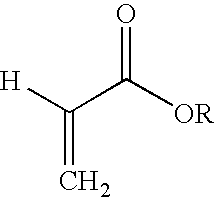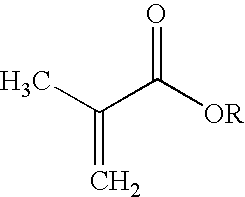Polymeric defoamer additive
a defoamer and additive technology, applied in the field of polymer defoamer additives, can solve the problems of ebs being found in unwanted deposits, contributing to deposition problems, and common industrial problems such as foam control, and achieve excellent defoamer activity, increase drainage, and increase the effect of examples
- Summary
- Abstract
- Description
- Claims
- Application Information
AI Technical Summary
Benefits of technology
Problems solved by technology
Method used
Image
Examples
example 1
Preparation of Acrylate Polymer in DIOA
[0069]A polymer containing 10-30% hydroxyl alkyl acrylate and 70-90% alkyl acrylate by weight percent was prepared as follows: 250 g of diisooctyl adipate (DIOA) was placed into a reaction flask. A vacuum was applied for 20 minutes to remove dissolved air. DIOA was sparged with nitrogen while being heated to 79-82° C. with mixing. Once at temperature and with the nitrogen sparge and constant mixing, a free radical generating compound was added and allowed to dissolve over a 5 minute period. Meanwhile, the acrylate monomers were pre-mixed in a beaker. The monomer mixture was added to the DIOA diluent through an addition funnel at a rate of approximately 1.5 g / minute, making sure to maintain a temperature of approximately 79-82° C. After the monomer blend addition, 48 g of DIOA were used to rinse the monomer blend container and addition funnel, and the DIOA rinse was added to the reaction flask. Another 0.5 g of free radical generating compound w...
example 2
[0071]Comparison to Example II of U.S. Pat. No. 5,152,925 ('925)
[0072]Experimental products were made following the formulations given in Example II of the '925 patent. Analogs of the examples were also made using the polymer from Example 1 above. Below are the formulations, along with their corresponding numerical designations, i.e., 265-57-1.
TABLE 2Example Products from the ′925 Patent265-57-1*(standard)265-55-1265-57-3Polybutene7050DIDP7020Acrylate Polymer in303030DIDP*Example from the ′925 patent
TABLE 3Analogs of the ′925 Patent Examples with Acrylate polymer in DIOA265-57-2265-55-2265-57-4Polybutene7050DIDP7020Acrylate Polymer in303030DIOA
TABLE 4Best Previous Performing Defoamer265-54-2Polypropylene Glycol58.5Hydrophobic Silica3Acrylate Polymer in DIOA23.5Polyether-Modified10Polysiloxane SiliconeSurfactantAlkyl Modified Siloxane5Silicone Wax
TABLE 5Polybutene Containing Samples*265-55-1265-55-2265-54-23000 μL3000 μL200 μL1st 30 Seconds6.58.411.2AreaTotal Runtime53.173.384.7AreaP...
example 3
Testing the Effects of Surfactants
[0074]The '925 patent states that the addition of a water soluble surfactant having a cloud point of 21-38° C., at levels of 0.25% to 3%, increases the drainage properties of the examples while maintaining excellent defoaming activity. In laboratory testing, the increase in drainage is typically measured as an increase in the performance of the defoamer during the 30 seconds after the defoamer is introduced. In an effort to test the examples, experimental products were made using the formulations from Example II in the '925 patent, and adding 0.25% and 3% of an ethylene oxide / propylene oxide block copolymer surfactant which meets the water solubility and cloud point criteria. These experimental products were tested and compared to the defoaming performance of 265-54-2. As in the case of Example II above, analogs of each of the samples were made using the Acrylate polymer in DIOA. Below are the formulations and test results obtained.
TABLE 8Formulatio...
PUM
| Property | Measurement | Unit |
|---|---|---|
| mol % | aaaaa | aaaaa |
| mol % | aaaaa | aaaaa |
| molecular weight | aaaaa | aaaaa |
Abstract
Description
Claims
Application Information
 Login to View More
Login to View More - R&D
- Intellectual Property
- Life Sciences
- Materials
- Tech Scout
- Unparalleled Data Quality
- Higher Quality Content
- 60% Fewer Hallucinations
Browse by: Latest US Patents, China's latest patents, Technical Efficacy Thesaurus, Application Domain, Technology Topic, Popular Technical Reports.
© 2025 PatSnap. All rights reserved.Legal|Privacy policy|Modern Slavery Act Transparency Statement|Sitemap|About US| Contact US: help@patsnap.com



